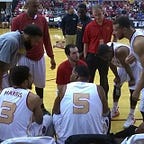“Horns Twist”
Term: Horns Twist
Definition: A half-court Horns set in which a ball-handler drags out an initial ball-screen toward the sideline before pivoting and using a second ball-screen coming from the middle.
Synonyms: N/A
Explanation: There are two main ways to create space in a given offensive play. The first is static, in that it only requires players to stand still on particular spot. The second is dynamic, in that it requires them to move into optimal spacing locations as the play unfolds.
This latter method is at the heart of most NBA sets, because they force off-ball defenders to stretch their responsbilities within an evolving structure. Against players that remain stationary, defenders have time to prepare and rotate early. Against movement (particular that which separates a defender from his assigned rotation), decision-making operates in real-time and is therefore harder.
Horns Twist — an extremely common variation on Horns action — is an effective way to stress defenders with spacing while ultimately relying on a simple 1–5 ball-screen. The play itself is a two-step process. With bigs on the elbows and wings in the corners, one big ball-screens and rolls followed by a second big doing the same.
What makes Horns Twist particularly effective is the way in which it initially mimics a regular Horns action. Take a look at the “Elbow” alignment the Dallas Mavericks set up in below, with both bigs on the elbows and the two wings moving toward the corners. This is how most Horns actions — along with various other common NBA sets — begin. For the defense, there’s no way to tell what’s coming unless a specific play-call has been overheard.
From here, the ball-handler, J.J. Barea, uses the ball-screen from the 4, Harrison Barnes. That the 4 sets the first ball-screen is not by accident (more on this in a moment.) Barnes, however, is part of the dummy action, and is meant to roll quickly and space out to the opposite corner or dunker spot. The shooting ability of the initial screener dictates to which spot he spaces. In most cases, this player “spaces to range,” meaning he goes as far away from the basket as he can reasonably make a shot. Here that means Barnes heads to the opposite corner while Nicolas Brussino, currently occupying the weak-side corner, lifts to the wing.
The reason for this dummy action is more than fluff. In an ideal scenario, the man guarding the ball — in this case Matthew Dellavedova of the Milwaukee Bucks — works hard to fight over the first screen and relaxes. In this moment, the other offensive big hits him with a screen on his inside shoulder. Not only can this catch him off guard, but it can occur with his momentum still carrying him in the opposite direction. Good point guards will even use the first ball-screen casually before “twisting” back middle off the second. All of this can make it especially difficult to fight over the second screen successfully.
Typical defensive countermeasures understand this predicament and react with a switch on the initial ball-screen. With the positional flexibility of most NBA defenses, switching 1–4 ball-screen actions is not necessarily problematic. But this also explains why having the 4 set the first ball-screen is so important. If the 4 sets the second ball-screen, the defense can switch the final action and completely blow up the play. If the 5 screens second, however, the defense is more likely to stick with traditional pick-and-roll coverage — a drop or a weak. At worst, the defense switches the 1–5 ball-screen as well, giving the offense the two biggest possible mismatches it can create.
In this Dallas-Milwaukee play, the Bucks switch the 1–4 ball-screen, but do not switch the second. Nerlens Noel, who runs the second pick-and-roll with Barea, gets an easy alley-oop dunk.
Looking at this more closely, there’s even more going on than initially meets the eye. Horns Twist actions also momentarily capitalize on what looks to be a defensive advantage: multiple bodies between the ball and the basket. Just look at how clogged the lane appears as Barea “twists” off the second ball-screen. How could anyone glide through the lane untouched?
Certainly Milwaukee makes some mistakes here, most notably Jason Terry in the strong-side corner who does not “tag” the rolling Noel and gives him free passage to the rim. But that’s exactly the point. Dellavedova, who is following Barnes as he clears to the weak-side corner, momentarily two-nines in the paint as a penetration deterrence. Thon Maker eyes the ball and the roller in his drop coverage. With so much going on, Terry seems to assume that someone will probably help.
But when that assumption is made by everyone — known as the bystander effect — no one actually helps. In this case, that’s what happens.
This is the beauty of dynamic spacing movement, as mentioned earlier. Instead of standing in stationary spacing spots, Horns Twist pulls Dellavedova into and out of a potential help position. What appears to be a clogged lane turns out to be exactly the opposite, with no one the wiser.
Film Study: “Horns Twist”
Below is a video compilation of various examples of NBA offenses running Horns Twist. Pay attention to how the defense guards the Twist action. Do they switch the first or second ball-screen? Do they play traditional coverage throughout? How does the evolving spacing dynamic impact defensive help?
